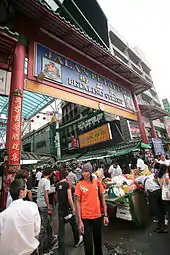Petaling Street
Petaling Street (Malay: Jalan Petaling, Simplified Chinese: 茨厂街, Traditional Chinese: 茨廠街, pinyin: Cíchǎng Jiē, Cantonese jyutping: ci4 cong2 gaai1) is a Chinatown located in Kuala Lumpur, Malaysia.[1] Haggling is a common sight here and the place is usually crowded with locals as well as tourists.

The area has dozens of restaurants and food stalls, serving local favourites such as Hokkien mee, Ikan Bakar (barbecued fish), asam laksa and curry noodles. Reggae Bar Chinatown is located here. Traders here are mainly Chinese but there are also Indian, Malay, and Bangladeshi traders. It is also known for street prostitution.[2]
History and development
The original Chinatown centred on Market Square. Jalan Tun H.S. Lee or High Street. The High Street was popular as it was higher than the rest of the town and was therefore less prone to floods, and the wealthier population were inclined to build their shophouses here. As a result, the more ornate shop houses were built north of Jalan Cheng Lock, and closer to the High Street business centre.
Kuala Lumpur was a typical "pioneer" town around the start of the 20th century. The population was largely male and they were typical of the rough and tough pioneers of those times.
The men were mainly Cantonese and Hakkas who had come to the city because of the tin trade, working as coolies in the mines. They were governed by a Chinese Kapitan or headman. The most famous Chinese Kapitan was Yap Ah Loy, a Hakka.[3]

In 1870, civil war erupted within the Chinese community. This was split along partisan lines between the Hokkien Ghee Hin and the Hakka Hai San secret societies. The British realising that the war is disrupting their economy and chain of supply, decided to enter the war. As a result of the long civil war, many buildings were destroyed or severely damaged.[4]
During this Selangor Civil War, the tin mines were abandoned. The neglect during this time caused them to become flooded. When the war was over, and when the miners returned after the war, they found that the mines were now unworkable due to flooding. Yap Ah Loy managed to persuade the miners and coolies to remain in KL and also persuaded the Malays in surrounding districts to grow rice and other garden products. He opened a Tapioca Mill in Petaling Street where the tubers from his farms were brought to be ground into flour. Petaling Street is fondly called 'Chee Cheong Kai' in Cantonese which means Starch Factory Street.
Features
There used to be a McDonald's on the 1st shop lot of Petaling Street (facing Foch Avenue (Jalan Tun Tan Cheng Lock)) before it ceased operations several years ago. Nearby is a Chinese bookstore, as well as food stalls selling a variety of local food like Hainanese chicken rice and noodles. There is one famous and established Wanton Noodle shop called Koon Kee too, it's located near the intersection inside Petaling Street. Also nearby are the Jamek Mosque, an old mosque of Moorish architecture as well as the Central Market, all accessible within walking distance. One of Kuala Lumpur's famous landmarks, the Sri Mahamariamman Temple, Kuala Lumpur, is located along Jalan Tun H.S. Lee. It is one of KL's oldest and richest Hindu temples, receiving many devotees and tourists daily.
Development
In 2003, Petaling Street underwent a major RM11 million face lift when two large Chinese arches to welcome visitors were placed at either end of the street. A green roof cover was constructed, covering the whole street, dubbed the "Green Dragon". The street is now totally pedestrianised and transformed into a pedestrian shopping mall. The Street is regarded as a heritage site.
Petaling Street is still the best place to shop for counterfeit branded products and for trying out its large selection of local Chinese cuisine. For buyers, it is often possible to haggle on the price of watches, clothing and all the counterfeit items. The Street is always crowded not only with tourists, but also with locals.
Film
Although not shot on site, Malaysia's first period kungfu comedy, Petaling Street Warriors, is set against the backdrop of Petaling Street in the year 1908.
Transportation
The street is accessible within walking distance from the following rail stations:
- Northwest from SP8 AG8 Plaza Rakyat LRT Station (interchange with SBK17 Merdeka MRT station);
- South from AG7 SP7 KJ13 Masjid Jamek LRT station;
- Northeast from KJ14 SBK16 Pasar Seni LRT/MRT Station - connected to KA02 KTM Kuala Lumpur; and
- North from MR3 Maharajalela Monorail station.
Image gallery
| Wikimedia Commons has media related to Petaling Street. |
 Closeup view of the iconic "Green Dragon"
Closeup view of the iconic "Green Dragon" Rows of shop behind the Green Dragon
Rows of shop behind the Green Dragon Hotel Lok Ann, located opposite the entrance
Hotel Lok Ann, located opposite the entrance
References
- "Petaling Street". www.malaysia.travel. Tourism Malaysia. Retrieved 28 April 2019.
- Hunter, Murray (28 July 2015). "Why Kuala Lumpur could be on its way to becoming the sex capital of Asia". Asian Correspondent. Retrieved 28 November 2017.
- "Dataran Merdeka". welcome-kl.com. Archived from the original on 21 May 2011. Retrieved 9 August 2007.
- "Why early Chinese settlers chose the site". The Star. Archived from the original on 19 July 2013. Retrieved 18 July 2012.